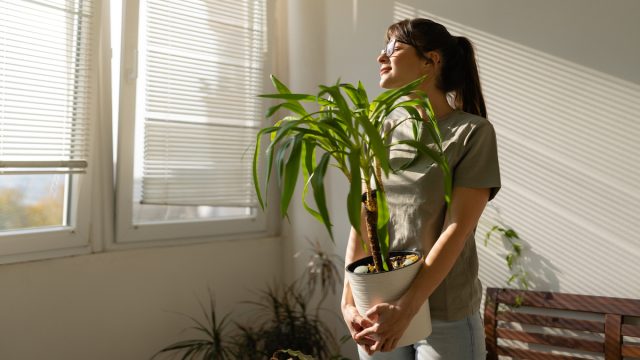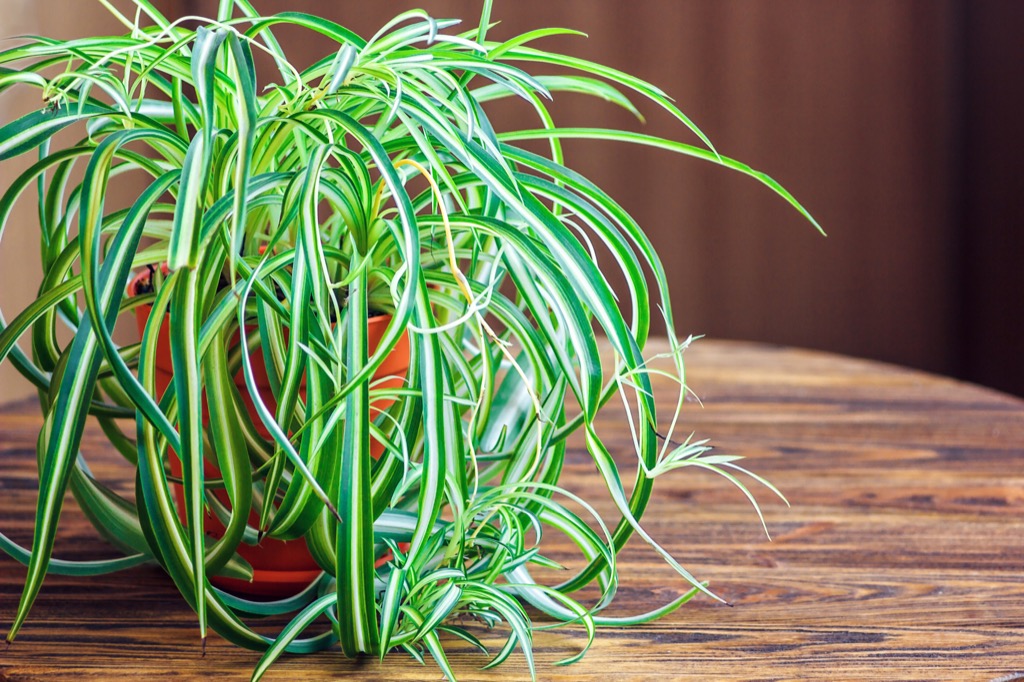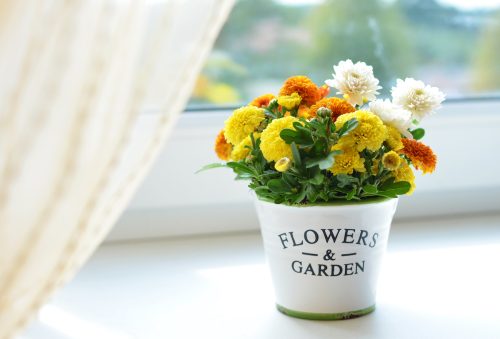9 Houseplants That Will Help You Breathe Better

There’s no easier way to brighten your space than by including plants in your decor. Whether you opt for a hanging vine or a windowsill planter, houseplants add life, energy, and beauty wherever they’re placed. And as it turns out, they could also help you breathe better. According to a landmark study by NASA, plants can reduce indoor air pollutants in a closed, limited environment. While it’s unclear how effective they are at performing that magic outside of laboratory conditions, it’s known that plants can spruce up the air at least in a small way. To bring their powers into your home, read on to discover the best air-purifying houseplants.
RELATED: 10 Easy Hacks to Save Your House Plants That Gardeners Swear By.
9 Air-Purifying Houseplants
1. Snake Plant

Snake plants are some of the hardiest plants out there, beloved for their ability to thrive in low light and with little water. Not to mention, their beautiful vertical green and yellow leaves can reach anywhere from several inches to several feet. And as they sit in your home, they’ll also clean the air.
One 2009 study published in HortTechnology found that lab chambers with snake plants in them saw a faster depletion of ozone concentration than chambers without them. Ozone is essentially smog, and inhaling it can attack the lungs and cause health problems, according to the American Lung Association. If these little plants can counter that, then we welcome them to do it.
2. Spider Plant

These overflowing houseplants are just as adaptable as snake plants. Put them in indirect light with well-drained soil and they’ll be perfectly happy.
In the NASA study that discovered plants’ air-purifying properties, spider plants removed 95 percent of the toxic substance formaldehyde—a cancer-causing gas that can irritate the skin, eyes, nose, and throat—from a chamber in 24 hours.
“And for pet owners, these plants are safe to spread throughout your home, as they are non-toxic to both cats and dogs,” adds Rebecca Sears, CMO and resident green thumb at Ferry-Morse.
RELATED: 8 Easy Houseplants That Don’t Need Sunlight.
3. English Ivy

This climbing houseplant can be used as an indoor vine to creep over hanging baskets or curtain rods.
NASA’s study found it to be the most effective houseplant for removing benzene, a toxic chemical created by tobacco smoke and industrial exhaust. It depleted almost 90 percent of benzene from the air and lowered the concentration of trichloroethylene—which can damage the immune and reproductive systems, among others, and cause some cancers—by almost 11 percent.
English Ivy prefers a moist environment and medium light. Just be careful, as the plant is toxic to humans and pets.
4. Peace Lily

According to the NASA study, the Peace Lily removed nearly 80 percent of benzene from the air and 23 percent of trichloroethylene—coming in as most effective for the latter.
“Benzene can be found in gasoline, rubber, paint, cigarette smoke, detergents, and many synthetic fibers,” explains Vladan Nikolic, a houseplant expert and founder of the blog Mr. Houseplant. “Trichloroethylene can be found in lacquer, paints, glue, and varnish.”
Vladan says this houseplant is pretty low-maintenance. It prefers bright, indirect light (though a few hours of direct sunlight each day is even better) and should be watered once the top half of the soil dries out.
RELATED: 8 Houseplants That Improve Your Mental Health, Science Says.
5. Golden Pothos

“Golden Pothos removes formaldehyde, benzene, and trichloroethylene from the air, thus improving the air quality and reducing the amount of harmful toxins in your home,” says Vladan. Benzene is where it is most effective, according to the NASA study, removing 73 percent of it from the air.
“Pothos is easy to care for and it can tolerate low light well,” notes Vladan. “However, if you give it more bright, indirect light it will produce new leaves faster, and the plant will be sturdier and more resilient to pests and diseases.”
6. Ficus

Ficus, commonly called fig trees, are uber-popular and look impossibly chic when placed in the corner of a room. In addition to their stylish appearance, they also have air-cleaning abilities.
The NASA study found they removed almost 48 percent of formaldehyde, 30 percent of benzene, and 10.5 percent of trichloroethylene. Keep them in the sun with moist soil and they’ll be happy to upgrade your air.
“These plants can grow between two and 10 feet tall,” notes Tatyana Zhuk, expert at the Plantum app. “They prefer bright indirect sunlight and weekly watering.”
RELATED: 8 Indoor Plants That Keep Bugs Away, According to Experts.
7. Dracaena

Dracaena is a genus of more than 120 plant species native to Africa. Most of them are known for their tropical-looking, pointy upright leaves. But four specific Dracaena are pointed out in the NASA study.
The first is the Dracaena warneckei, known for its rising tiers of leaves, which removed 50 percent of formaldehyde, 52 percent of benzene, and 10 percent of trichloroethylene.
The Dracaena deremensis, better known as the Janet Craig plant or corn plant, is noted for its striped green/yellow leaves. It removed just over 17 percent of trichloroethylene and 78 percent of benzene.
Next, the Dracaena marginata removed 13 percent of trichloroethylene and 79 percent of benzene. It’s known as the dragon tree for its red-tinged, long and pointy leaves.
Finally, the Dracaena massangeana removed 70 percent of formaldehyde—the most of any houseplant studied—21 percent of benzene, and nearly 13 percent of trichloroethylene. Referred to as corn cane or mass cane, it has shiny bright green leaves with yellow stripes.
Do note that these plants contain sap that is poisonous to dogs and cats.
For more plant advice delivered straight to your inbox, sign up for our daily newsletter.
8. Chrysanthemum

Flowering plants can provide air purification benefits, too. The NASA study put potted mums to the test and found that in a 24-hour period, they cleared 61 percent of formaldehyde, 53 percent of benzene, and 41 percent of trichloroethylene from a sealed chamber.
Mums are somewhat easy to care for and require full sunlight and frequent watering.
9. Gerbera Daisy

The gerbera daisy is another flowering plant that offers color and better air quality. In the NASA study, it reduced formaldehyde by 50 percent, benzene by almost 68 percent, and trichloroethylene by 35 percent.
To care for these flowers, put them in bright light (this is key, or they may not produce blooms) and water them when they feel dry. They’ll develop long-lasting flowers from spring until autumn, but unfortunately, they are annuals and usually only last one season.
- Source: https://ntrs.nasa.gov/citations/19930073077
- Source: https://journals.ashs.org/horttech/view/journals/horttech/19/2/article-p286.xml
- Source: https://www.lung.org/clean-air/outdoors/what-makes-air-unhealthy/ozone
- Source: https://ntrs.nasa.gov/api/citations/19930073077/downloads/19930073077.pdf